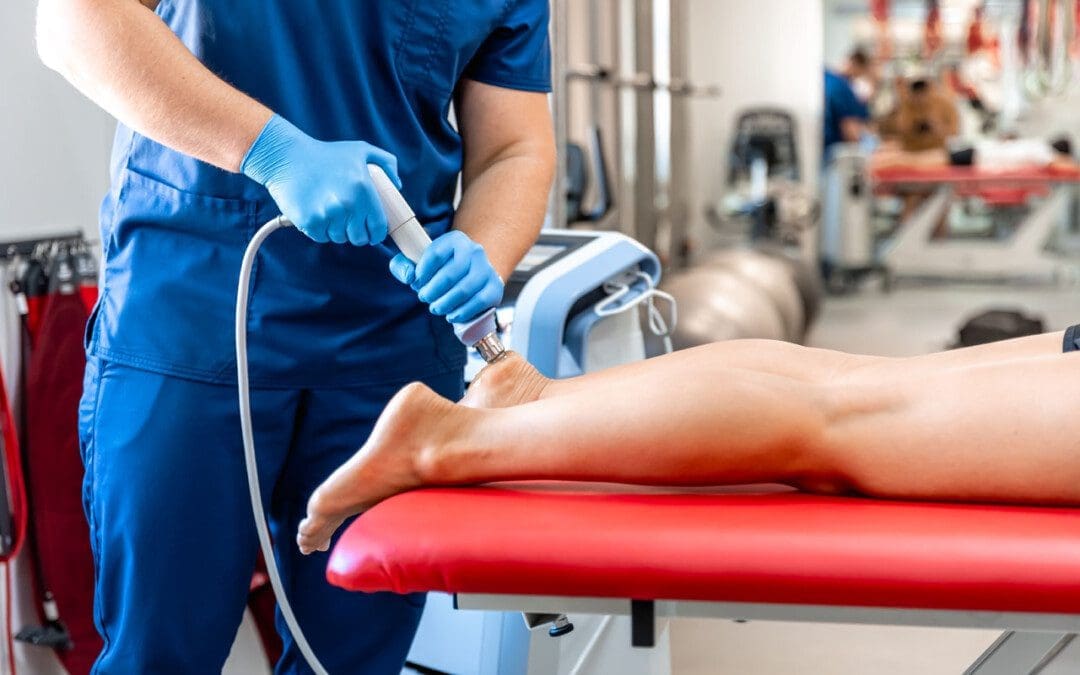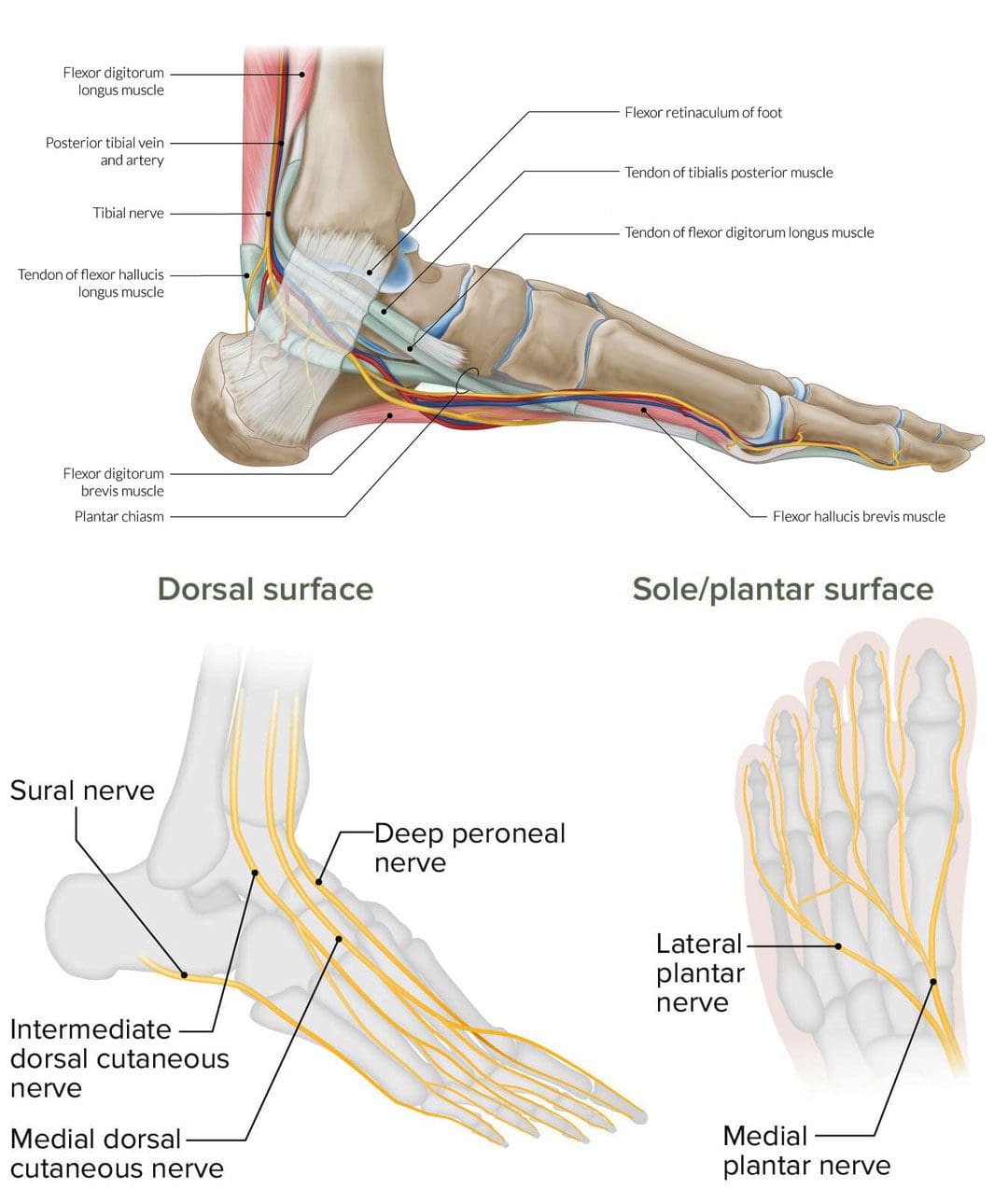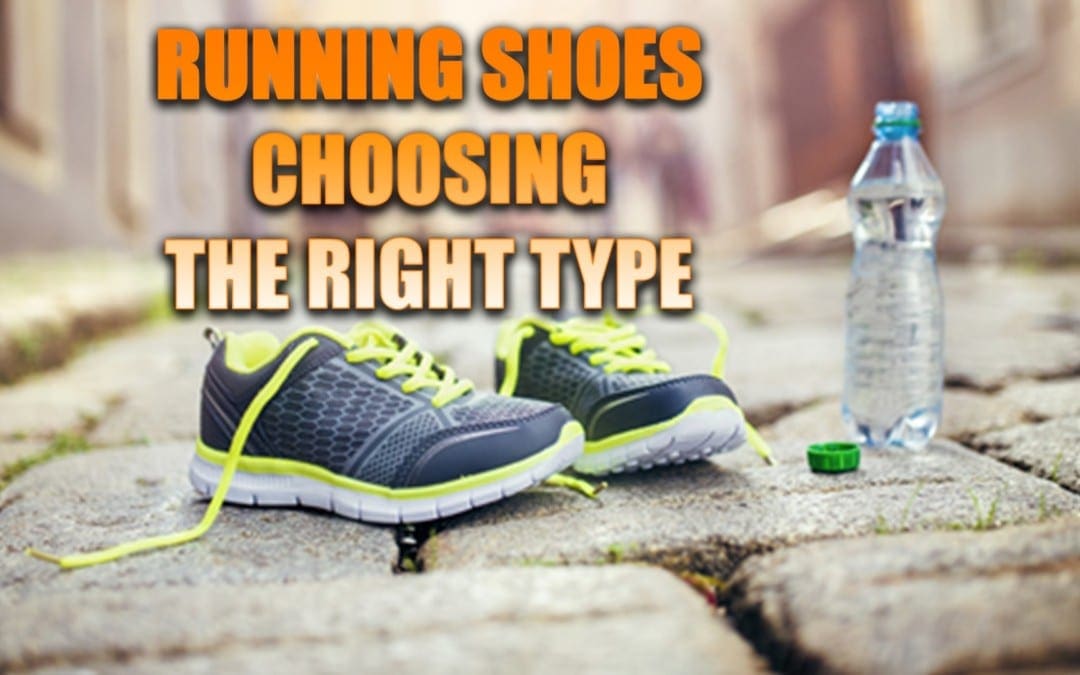
Understanding the Causes of Nerve Pain in Your Foot
Individuals that experience nerve pain in the foot could be caused by a number of different conditions, can recognizing the most common causes help in developing an effective treatment plan?

Nerve Pain In The Foot
These sensations can feel like a burning, shooting, electrical, or stabbing pain and can happen while in motion or at rest. It can occur on the top of the foot or through the arch. The area closest to the nerve may be sensitive to the touch. A number of different conditions can cause nerve pain in the foot, including:
- Morton’s neuroma
- Pinched nerve
- Tarsal tunnel syndrome
- Diabetic peripheral neuropathy
- Herniated disc
Morton’s Neuroma
Morton’s neuroma involves the nerve that runs between the third and fourth toes, but can sometimes occur between the second and third toes becoming thicker. Typical symptoms include a burning or shooting pain in the area, usually while walking. (Nikolaos Gougoulias, et al., 2019) Another common symptom is the sensation of pressure beneath the toes like the sock is bunched up underneath. Treatments can include:
- Arch supports
- Cortisone injections to decrease swelling
- Footwear modifications – can include lifts, orthotics combined with metatarsal pads, and rocker soles, to provide cushion where needed.
Things that increase the risk of developing the condition include:
- Regularly wearing high-heels – the condition occurs more frequently in women.
- Shoes that are too tight.
- Participating in high-impact sports like running.
- Having flat feet, high arches, bunions, or hammertoes.
Pinched Nerve
A pinched nerve can feel like shooting or burning pain. Nerve entrapment can occur in various regions of the foot or the area on top of the foot may feel sensitive. Causes can be caused by: (Basavaraj Chari, Eugene McNally. 2018)
- Trauma that causes swelling.
- Blunt impact.
- Tight shoes.
Treatment can include:
- Massage
- Physical therapy
- Rest
- Footwear modifications
- Anti-inflammatories.
Things that increase the risk of developing a pinched nerve in the foot include:
- Poor-fitting footwear.
- Repetitive stress injury.
- Trauma to the foot.
- Obesity.
- Rheumatoid arthritis.
Tarsal Tunnel Syndrome
Another type of nerve entrapment is tarsal tunnel syndrome. Tarsal tunnel syndrome is “anything that produces compression on the posterior tibial nerve.” (American College of Foot and Ankle Surgeons. 2019) The tibial nerve is located near the heel. Symptoms include numbness and foot cramps, burning, tingling, or shooting sensations that often radiate from the instep/arch. Both can worsen while the foot is at rest, like when sitting or sleeping. Treatment can consist of:
- Placing padding in the shoe where the foot is being compressed to relieve the pain.
- Custom foot orthotics.
- Cortisone shots or other anti-inflammatory treatments.
- Surgery may be necessary to release the nerve.
Conditions that compress the tibial nerve and can lead to tarsal tunnel syndrome include:
- Flat feet
- Fallen arches
- Ankle sprain
- Diabetes
- Arthritis
- Varicose veins
- Bone spurs
Diabetic Peripheral Neuropathy
Long-term high blood sugar/glucose associated with diabetes can lead to a form of nerve damage known as peripheral neuropathy. (Centers for Disease Control and Prevention. 2022) Neuropathy pain feels like burning or shooting pain, or the sensation of walking on bubble wrap that usually shows up overnight. The pain can come and go as well as a gradual loss of feeling in the feet that begins in the toes and moves up the foot. It’s estimated that around half of individuals with diabetes will eventually develop neuropathy. (Eva L. Feldman, et al., 2019) Treatments can include:
- Physical therapy massage to increase circulation.
- Topical treatments with capsaicin.
- Vitamin B.
- Blood sugar management.
- Alpha lipoic acid.
- Medication.
Individuals with diabetes have an increased risk of developing peripheral neuropathy if:
- Blood sugar is not well-controlled.
- Diabetes has been present for many years.
- Kidney disease.
- Smoke.
- Overweight or obese.
Herniated Disc
Nerve pain in the foot can be caused by spinal issues. A herniated disc in the lower back can irritate and compress the nerves, causing pain that radiates down the leg and foot. Additional symptoms usually include muscle weakness in the legs and/or numbness and tingling. Most herniated discs don’t require surgery and get better with conservative treatment. (Wai Weng Yoon, Jonathan Koch. 2021) If symptoms don’t improve or worsen, a healthcare provider may recommend surgery. Herniated discs are most common in young and middle-aged adults. Increased chances of developing a herniated disc can come from:
- Degenerative changes in the spine from normal age wear and tear.
- Physically demanding job.
- Lifting incorrectly.
- Overweight or obese.
- Genetic predisposition – family history of herniated discs.
Spinal Stenosis
Spinal stenosis occurs when the spaces in the spine begin to narrow, creating pressure on the spinal cord and nerve roots. It is usually caused by wear and tear on the spine as the body ages. Stenosis in the lower back can cause burning pain in the buttocks and leg. As it progresses pain can radiate into the feet along with numbness and tingling. Conservative treatment consists of physical therapy exercises and non-steroidal anti-inflammatory medications/NSAIDs. (Jon Lurie, Christy Tomkins-Lane. 2016) Cortisone injections can be beneficial and if the condition worsens, surgery may be an option. Risk factors include:
- Age 50 or older.
- A narrow spinal canal.
- Previous injury.
- Previous spinal surgery.
- Osteoarthritis that is affecting the back.
Other Possible Causes
Other conditions can result in nerve damage and pain symptoms and sensations. Examples include: (Nathan P. Staff, Anthony J. Windebank. 2014)
- Vitamin deficiencies (Nathan P. Staff, Anthony J. Windebank. 2014)
- Physical trauma – after surgery or an automobile or sports accident.
- Certain cancer, antiviral medications, or antibiotics.
- Complex regional pain syndrome.
- Tumors that irritate and/or compress a nerve.
- Liver or kidney disease.
- Infectious diseases – Lyme disease complications or viral infections.
Nerve pain in the foot is definitely a reason to see a healthcare provider. Early diagnosis can help prevent symptom progression and future problems. Once the cause of the pain has been identified, the healthcare team can work together to develop a personalized treatment plan to release compressed nerves and restore mobility and function. See a healthcare provider right away if the pain and symptoms worsen, or if there are difficulties standing or walking.
Chiropractic After Accidents and Injuries
References
Gougoulias, N., Lampridis, V., & Sakellariou, A. (2019). Morton’s interdigital neuroma: instructional review. EFORT open reviews, 4(1), 14–24. doi.org/10.1302/2058-5241.4.180025
Chari, B., & McNally, E. (2018). Nerve Entrapment in Ankle and Foot: Ultrasound Imaging. Seminars in musculoskeletal radiology, 22(3), 354–363. doi.org/10.1055/s-0038-1648252
American College of Foot and Ankle Surgeons. Tarsal tunnel syndrome.
Centers for Disease Control and Prevention. Diabetes and nerve damage.
Feldman, E. L., Callaghan, B. C., Pop-Busui, R., Zochodne, D. W., Wright, D. E., Bennett, D. L., Bril, V., Russell, J. W., & Viswanathan, V. (2019). Diabetic neuropathy. Nature reviews. Disease primers, 5(1), 42. doi.org/10.1038/s41572-019-0097-9
Yoon, W. W., & Koch, J. (2021). Herniated discs: when is surgery necessary?. EFORT open reviews, 6(6), 526–530. doi.org/10.1302/2058-5241.6.210020
Lurie, J., & Tomkins-Lane, C. (2016). Management of lumbar spinal stenosis. BMJ (Clinical research ed.), 352, h6234. doi.org/10.1136/bmj.h6234
Staff, N. P., & Windebank, A. J. (2014). Peripheral neuropathy due to vitamin deficiency, toxins, and medications. Continuum (Minneapolis, Minn.), 20(5 Peripheral Nervous System Disorders), 1293–1306. doi.org/10.1212/01.CON.0000455880.06675.5a







